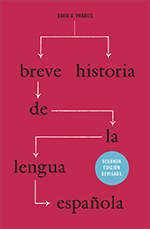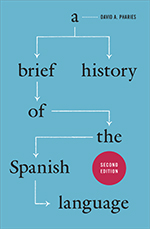Sugerencias
Suggestions
Errata
Five representative samples of Spanish varieties
Supplement to Chapter 9 “Spanish Varieties” of A Brief History of the Spanish Language, second edition.
One of the most interesting features of Chapter 9 is its array of speech samples in the form of web videos representing the varieties typical of five different regions of the Spanish-speaking world: Andalusia, the River Plate region of Argentina (customarily referred to as Rioplatense), the Andes, the Caribbean, and Mexico. The purpose of this webpage is to provide a second venue for these speech samples (especially in the event that they are removed from the web at some future date), as well as a brief commentary on each sample, while still leaving plenty of opportunity for student analysis.
1. Andalusian variety: (Charla medico 24 horas en la Roda de Andalucia)
This is a speech by the mayor of La Roda de Andalucía, a town of 4,297 inhabitants (2014) in the province of Seville, Spain, 127 km to the southeast of the city of Seville and 17 km from the town of Estepa, which is roughly three times larger. In the video the mayor laments the loss of a local clinic and the transferal of medical services to Estepa. The following is a transcription of his speech beginning at 2:16, following by a translation.
Pero sí es verdad que en el año ochenta y dos en el año ochenta había médicos que dormían en nuestros pueblos y que tenían una existencia, había en el pueblo una existencia más cercana. Una existencia en la que tú llamabas a cualquier hora y a ti te atendían porque estaban aquí en nuestros pueblos los médicos viviendo conviviendo con nosotros y también tenían unos días, cada médico, de urgencia y nos atendían. Eso ha evolucionado hacia el sistema de salud más moderno pero más alejado, hacia el sistema de salud que están fuera del ámbito de nuestros pueblos y que tardan, como mínimo, treinta minutos como mínimo en llegar si le coge la ambulancia en Estepa.
Translation: “But it is true that in the year 82, in the year 80 there were doctors who slept in our towns and who had their existence here, a more proximate existence. An existence in which you called at any time and they saw you because here in our towns there were doctors living, coexisting with us and also each doctor had days on call and they saw us. That has evolved into the more modern but more remote health system, toward a health system where they are outside the sphere of our towns and take at least thirty minutes at least to arrive if the ambulance picks them up in Estepa.”
The most notable phonetic features in the video, all typical of Andalusian speech, are (1) seseo, (2) the dorso-dental articulation of /s/, similar to that heard in most varieties of American Spanish, (3) various levels of aspiration, up to and including loss, of syllable-final /s/, (4) the use of glottal /h/ instead of Castilian /x/, and (5) velarization of final /n/. Later on in the recording one notices some of the variation typical of /r/ and /l/ in syllable-final position.
2. Rioplatense: (Ana Ojeda, Falso contacto)
This is an interview of Argentine author Ana Ojeda by Natu Poblet on the program “Nuevas voces de la narrative argentina”. Ana talks about her novel Falso contacto. The following is a transcription of her interview beginning at 3:12, following by a translation.
Sí, en realidad, como vos decís Natu, la inmigración es uno de los temas que a mí me apasiona, sobre todo en lo que tiene que ver con ese transterraje. Es decir, cuando nosotros nos mudamos o nos vamos a vivir a otro lado, ¿qué es lo que llevamos con nosotros del lugar que nos crió o en el cual vivimos? ¿y qué es lo que no nos podemos llevar, ¿no? Yo viví el 2001 acá, y un poco, empecé a pensar la novela como, desde un costado irónico, digamos, porque todas estas familas que llegan alrededor de 1900 a Buenos Aires son las familias que después tienen nietos o bisnietos que terminan yéndose de vuelta a Europa en 2001.
Translation: “Yes, really, as you say Natu, immigration is one of the topics that interests me, especially as it involves changing locations. That is to say, when we move or go to live in a new place, what do we take with us from the place where we grew up or in which we live? And what can we not take? Right? I lived through 2001 here, and sort of started to think of the novel as, from an ironic point of view, let’s say, because all these families that arrive in Buenos Aires around 1900 are the families that afterward have grandchildren or great-grandchildren who end up back in Europe in 2001.”
Typical Rioplatense characteristics exhibited here are (1) voseo, (2) seseo, (3) aspiration of syllable-final /s/ that does not lead to loss and, most notably, (4) ʃeísmo, i.e., the use of /ʃ/ for /j/.
3. Andean Spanish: (Facultad de Ciencias Médicas de la Universidad de Cuenca)
This is an interview with Dr. Arturo Quizhpe P., Dean of the School of Medicine at the University of Cuenca, who outlines the mission of his unit at the University. The following is a transcription of his comments beginning at 0:41, following by a translation.
La Facultad de Ciencias Médicas de la Universidad de Cuenca con una historia de más de cien años ha contribuido al desarrollo de la medicina de la enfermería y de las diferentes carreras de tecnología en el austro y en y en el país. Uno de los aspectos esenciales que ha trascendido ha sido justamente el haber participado activamente en la elaboración de propuestas para mejorar la calidad de vida y para asimismo a través de la investigación poner a los niveles de adhesión política las evidencias científicas necesarias que permitan elaborar política pública.
Translation: “The College of Medicine of the University of Cuenca, with a history of more than 100 years, has contributed to the development of medicine, nursing and diverse technological careers in the south and the country. One of the essential aspects that has emerged has been precisely having participated actively in the elaboration of proposals to improve the quality of life and also, through research, to provide to the levels of political adherence the scientific information needed for the elaboration of public policy.”
Typical Andean characteristics exhibited here include (1) seseo, (2) absence of aspiration of syllable-final /s/, (3) assibilated pronunciation of /r/ (as [ř]), (4) velarization of syllable-final /n/, (5) voiced liaison with final /s/ ([lo zas ‘pek tos]), and (6) vowel reduction (e.g., in the word participación).
4. Caribbean Spanish: (Documental Cubano: La esperanza de Cuba)
This is a documentary about Livio Fernández Ruiz, a Cuban dissident who leads the group Juventud Activa/Cuba Unida. The following is a transcription of his comments beginning at 2:20, following by a translation.
Son carteles para nada gubernamentales antigubernamentales sino carteles que dicen vivan los niños cubanos, porque en esta área se organizan los fines de semana eventos y actividades para niños. Y bueno, los invito a pasar. Aquí podrán ver la biblioteca independiente que que tenemos. En este lugar pequeño que ustedes ven, se dan talleres y se hacen actividades con niños infantiles como verá aquí cuadernos que son de de las clases que se se le imparten a los niños que vienen. Clases de temas de inglés….
Translation: “They are posters that are not at all governmental, antigovernmental but just posters that say ‘long live Cuban children’, because in this area events and activities for children are organized during the weekends. And so, I invite you to come in. Here you will see the independent library that we have. In this small place that you see, there are workshops and activities for children, like you see here notebooks that are for the classes that are taught to the children that come. Classes on topics like English….”
Typical Caribbean characteristics include (1) seseo, (2) various levels of aspiration, including loss, of syllable-final /s/, (3) the use of glottal /h/ for Castilian /x/, (4) velarization of final /n/, (5) weakening, often to the point of loss, of intervocalic /bdg/, and (6) variation typical of /r/ and /l/ in syllable-final position, including replacement of /r/ by /l/ and elision followed by gemination of the following consonant.
5. Mexican Spanish: (Entrevista Bernardo Fernández BEF)
This is an interview of Mexican author and critic Bernardo Fernández, commonly known as BEF, talking about his participation in a literary project. The following is a transcription of his comments beginning at 0:18, following by a translation.
Yo me sentí muy honrado que nos invitaron eh…porque… supongo que el hecho de estar contemplado, ¿no? en un proyecto de este tipo implica que mi trabajo narrativo tiene alguna resonancia. Tenía un cuento que, breve, que Carne Natal se llama, que además era es un cuento de ciencia ficción como muy, como muy alejado en su contexto…todo en el espacio profundo durante miles de años. Entonces me parecía que era una idea como lo suficientemente extraña como para provocar alguna reacción en alguien que, bueno, de entrada no tenía ningún contacto previo con, o suponía yo, con este tipo de historias, de lecturas.
Translation: “I felt very honored that they invited us…because…I suppose the fact of being thought of, you know, in a project of this type implies that my narrative work has some resonance. I had a story that, short, that was entitled Carne Natal, which besides was a science fiction story like really, really far away in its setting…all in deep space during thousands of years. So, it seemed like an idea that was strange enough to provoke a reaction in someone who, well, to begin with did not have previous contact with, or I supposed, with this kind of stories, of readings.”
Among the characteristics typical of standard Mexican speech are (1) seseo, (2) non-aspiration of syllable-final /s/ and above all, (3) vocalic reduction up to and including elision.

